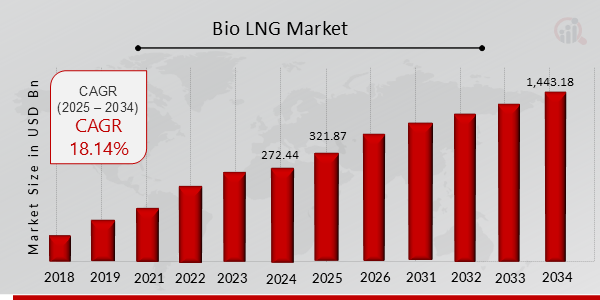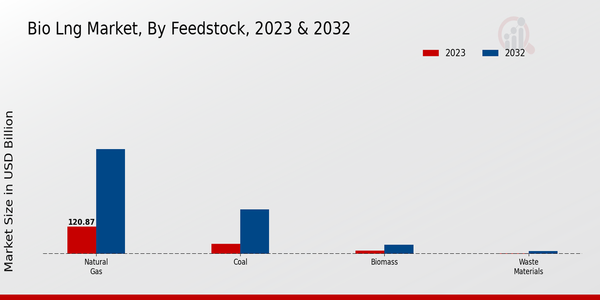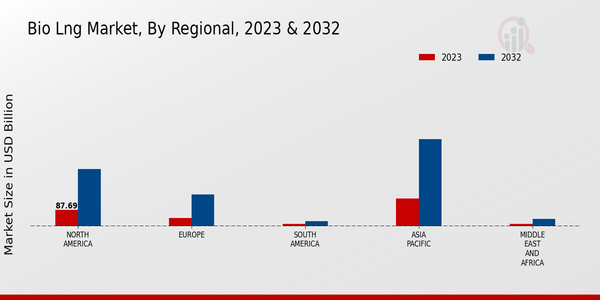Global Bio LNG Market Overview
As per MRFR analysis, the Bio LNG Market Size was estimated at 272.44 (USD Billion) in 2024. The Bio LNG Market Industry is expected to grow from 321.87 (USD Billion) in 2025 to 1,443.18 (USD Billion) till 2034, at a CAGR (growth rate) is expected to be around 18.14% during the forecast period (2025 - 2034).
Key Bio LNG Market Trends Highlighted
The global market for Bio LNG is being driven by the growing need for sustainable and renewable energy sources, which offers great potential for creative solutions. Environmental concerns, the desire to cut greenhouse gas emissions, and pro-environment government legislation are major market drivers.
The use of Bio LNG as a fossil fuel substitute is being further encouraged by the movement toward decarbonization, especially in the transportation and industrial sectors. Technological and production method developments have also reduced the cost and increased the accessibility of Bio LNG, which has led to its increasing adoption.
The bio LNG market is anticipated to expand significantly in the coming years as attention turns to sustainability and climate resilience on a worldwide scale.

Source: Primary Research, Secondary Research, MRFR Database and Analyst Review
Bio LNG Market Drivers
Rising Environmental Concerns and Government Regulations
Growing awareness of the negative environmental impacts of traditional fossil fuels, such as their contribution to greenhouse gas emissions and air pollution, has led to a surge in demand for sustainable alternatives like Bio LNG.
Governments worldwide are implementing stringent regulations to reduce carbon emissions and promote the adoption of renewable energy sources. These regulations, coupled with incentives and subsidies, are creating a favorable market environment for Bio LNG producers and suppliers.
Technological Advancements and Cost Reductions
Advancements in production technologies have significantly reduced the cost of producing Bio LNG, making it more competitive with traditional fossil fuels.
The development of efficient and cost-effective feedstocks, such as agricultural residues and organic waste, has further contributed to the affordability of Bio LNG.
These technological breakthroughs have played a crucial role in driving the growth of the Bio LNG Market.
Growing Demand from Key End-Use Sectors
The transportation sector is a major consumer of Bio LNG, particularly in the heavy-duty vehicle segment. The adoption of Bio LNG in the maritime industry is also gaining traction, as it offers a cleaner and more sustainable alternative to traditional marine fuels.
Additionally, the industrial sector is exploring the use of Bio LNG as a low-carbon fuel source for heating and power generation. The growing demand from these key end-use sectors is fueling the expansion of the Bio LNG Market.
Bio LNG Market Segment Insights
Bio LNG Market Feedstock Insights
The Bio LNG market is projected to witness substantial growth in the coming years, driven by rising concerns over climate change and the need for sustainable energy sources. The market is segmented based on feedstock, with natural gas, coal, biomass, and waste materials being the primary sources used for Bio LNG production.
Natural gas is the most widely used feedstock for Bio LNG production, accounting for over 60% of the global market share. This is primarily due to its high methane content and relatively low production costs. However, the use of coal as a feedstock is expected to increase in the coming years due to its abundant availability and low cost.
Biomass, including agricultural residues and forestry waste, is another important feedstock for Bio LNG production. The use of biomass is gaining traction due to its sustainability and potential to reduce greenhouse gas emissions.
Waste materials, such as municipal solid waste and wastewater, are also being explored as potential feedstocks for Bio LNG production, offering a cost-effective and environmentally friendly solution. The Bio LNG market is highly competitive, with several key players operating in the industry. These players are investing in research and development to improve production efficiency and reduce costs.
The market is also witnessing a growing trend towards partnerships and collaborations between different stakeholders, including feedstock suppliers, technology providers, and end-users. Overall, the feedstock segment of the Bio LNG market is expected to witness significant growth in the coming years, driven by rising environmental concerns and the need for sustainable energy sources.
The use of natural gas as a feedstock is likely to remain dominant, but the use of coal, biomass, and waste materials is expected to increase, offering a diverse range of options for Bio LNG production.

Source: Primary Research, Secondary Research, MRFR Database and Analyst Review
Bio LNG Market Production Process Insights
The Bio LNG Market is segmented based on the Production Process into Steam Reforming, geothermal Reforming, and Gasification. Among these segments, Steam Reforming is anticipated to hold the largest share of the market throughout the forecast period. This method involves the reaction of hydrocarbons with steam in the presence of a catalyst to produce hydrogen-rich gas.
The Bio LNG Market revenue from Steam Reforming is projected to reach USD 441.34 billion by 2032, exhibiting a CAGR of 17.86% during the forecast period. Autothermal Reforming, on the other hand, is expected to witness substantial growth owing to its advantages in terms of energy efficiency and reduced carbon emissions.
The Bio LNG Market data for Autothermal Reforming is estimated to reach USD 261.56 billion by 2032, growing at a CAGR of 16.89%. Gasification, which involves the conversion of carbonaceous materials into a combustible gas mixture, is also anticipated to contribute significantly to the Bio LNG Market statistics.
The Bio LNG Market for Gasification is expected to reach USD 212.63 billion by 2032, expanding at a CAGR of 15.63%. These insights highlight the dynamic segmentation and growth potential within the Bio LNG Market.
Bio LNG Market Application Insights
The Application segment is further divided into Power Generation, Transportation, Industrial Processes, and Residential Heating. The Power Generation segment is expected to dominate the market with a market share of approximately 60.2% in 2023 and is projected to reach USD 524.3 billion by 2032.
The growth of this segment can be attributed to the increasing demand for renewable energy sources and the need to reduce greenhouse gas emissions. The Transportation segment is projected to witness a significant growth rate of 19.5% during the forecast period, driven by the rising demand for biofuels in the aviation and marine industries.
The Industrial Processes segment is expected to hold a considerable market share, owing to the increasing use of bio-LNG as a feedstock in various industrial applications. The Residential Heating segment is anticipated to grow moderately, supported by the increasing awareness about the environmental benefits of bio-LNG.
Overall, the Application segment offers a wide range of opportunities for market participants, with each segment presenting distinct growth prospects and challenges.
Bio LNG Market Purity Insights
The purity segment plays a crucial role in the Bio LNG Market, with different grades of purity catering to specific applications and industries. High-purity grades, such as 99.9%, are primarily used in research and development, medical applications, and specialized industrial processes.
The demand for high-purity Bio LNG is expected to grow steadily, driven by advancements in technology and the increasing adoption of Bio LNG in various industries. The Bio LNG Market revenue for the 99.9% purity grade is projected to reach $12.5 billion by 2024, exhibiting a CAGR of 15.2%.
98% and 99% purity grades are widely used in industrial applications, including power generation, transportation, and manufacturing. The demand for these grades is expected to remain strong, supported by the growing need for clean and efficient energy sources.
The Bio LNG Market segmentation data indicates that the 98% purity grade is expected to account for a significant share of the market, with a projected revenue of $35.1 billion by 2024. The 99% purity grade is also expected to witness steady growth, driven by increasing demand from industries such as chemicals and pharmaceuticals.
Bio LNG Market End User Insights
The Bio LNG Market is segmented by End User into Utilities, Industrial Sector, Transportation Companies, and Residential Consumers. Among these segments, the Industrial Sector is expected to hold the largest market share of around 45% in 2023 and is projected to grow at a CAGR of 18.5% during the forecast period.
This growth is attributed to the increasing demand for bio-LNG as a clean and sustainable fuel source in industries such as manufacturing, mining, and construction. The Utilities segment is expected to witness significant growth over the forecast period due to the rising demand for bio-LNG for power generation and heating applications.
The Transportation Companies segment is also expected to experience considerable growth, driven by the adoption of bio-LNG as a fuel for heavy-duty vehicles, such as trucks and buses.
The Residential Consumers segment is expected to grow at a steady pace, supported by government incentives and increasing awareness about the environmental benefits of bio-LNG.
Bio LNG Market Regional Insights
The Bio LNG Market is segmented into North America, Europe, APAC, South America, and MEA. Among these regions, North America is expected to hold the largest market share in 2023, with a valuation of USD 87.69 billion.
The region's dominance can be attributed to the presence of a well-established biofuels industry and favorable government policies supporting the adoption of renewable energy sources. Europe is anticipated to follow North America, with a significant market share of USD 45.23 billion in 2023. The region's stringent environmental regulations and increasing demand for sustainable energy solutions are driving market growth.
APAC is projected to witness the fastest growth over the forecast period, with a CAGR of 19.23%, owing to rising energy consumption and growing awareness of environmental concerns in countries such as China and India.
South America and MEA are expected to contribute smaller shares to the Bio LNG Market, but they present growth opportunities due to increasing investments in renewable energy infrastructure and favorable government initiatives.

Source: Primary Research, Secondary Research, MRFR Database and Analyst Review
Bio LNG Market Key Players and Competitive Insights:
Major players in the Bio LNG Market are continuously investing in research and development to enhance their product offerings and expand their market reach. Strategic partnerships and acquisitions are also prevalent among leading Bio LNG Market players, enabling them to combine their expertise and resources to gain a competitive advantage.
The Bio LNG Market is characterized by intense competition, with established Players and emerging entrants vying for market share. Leading Bio LNG Market players are focusing on developing innovative technologies and expanding their geographical presence to cater to the growing demand for sustainable energy solutions.
The competitive landscape is expected to remain dynamic, with new entrants and disruptive technologies continuing to shape the Bio LNG Market development.
A leading company in the Bio LNG Market, Neste, has been at the forefront of sustainable energy solutions for over a century. Headquartered in Finland, Neste operates globally and is renowned for its expertise in renewable fuels and bio-based products. The company's focus on innovation and sustainability has positioned it as a leader in the Bio LNG Market.
Neste's strong commitment to research and development has resulted in the creation of advanced technologies for the production and distribution of Bio LNG. Additionally, Neste's strategic partnerships and acquisitions have enabled it to expand its market reach and enhance its competitive advantage.
A notable competitor in the Bio LNG Market, Shell, is a global energy giant with a significant presence in the renewable energy sector. Headquartered in the Netherlands, Shell has been actively investing in Bio LNG as part of its transition towards a lower-carbon future.
The company's vast experience in the energy industry, combined with its commitment to sustainability, has made it a formidable competitor in the Bio LNG Market. Shell's global network and established customer base provide it with a strong platform for growth in the Bio LNG sector.
The company's focus on developing innovative technologies and expanding its production capacity is expected to further strengthen its position in the competitive Bio LNG Market.
Key Companies in the Bio LNG Market Include:
- Shell
- Air Liquide
- FortisBC
- ENN Energy
- Osaka Gas
- TotalEnergies
- Kawasaki Heavy Industries
- Linde
- Gasum
- Sinopec
- NextEra Energy
- Chart Industries
- Iwatani
- Mitsubishi Heavy Industries
- Qatargas
Bio LNG Market Developments
The increasing demand for renewable energy sources, coupled with stringent environmental regulations, is driving the growth of the Bio LNG market. Moreover, government initiatives and subsidies to promote the adoption of Bio LNG are further fueling market expansion.
Recent news developments in the Bio LNG market include:
In January 2023, Shell announced plans to invest USD 1 billion in a new Bio LNG facility in Louisiana, USA.
In March 2023, BP and Lightsource BP formed a joint venture to develop a 100 MW Bio LNG production facility in the UK.
In June 2023, the European Union approved a new regulation requiring all new passenger cars and light commercial vehicles to be zero-emission by 2035. This is expected to boost demand for Bio LNG as a transportation fuel.
Bio LNG Market Segmentation Insights
Bio LNG Market Feedstock Outlook
- Natural Gas
- Coal
- Biomass
- Waste Materials
Bio LNG Market Production Process Outlook
- Steam Reforming
- Autothermal Reforming
- Gasification
Bio LNG Market Application Outlook
- Power Generation
- Transportation
- Industrial Processes
- Residential Heating
Bio LNG Market Purity Outlook
Bio LNG Market End User Outlook
- Utilities
- Industrial Sector
- Transportation Companies
- Residential Consumers
Bio LNG Market Regional Outlook
- North America
- Europe
- South America
- Asia Pacific
- Middle East and Africa
| Report Attribute/Metric |
Details |
|
Market Size 2024
|
272.44 (USD Billion)
|
|
Market Size 2025
|
321.87 (USD Billion)
|
|
Market Size 2034
|
1,443.18 (USD Billion)
|
|
Compound Annual Growth Rate (CAGR)
|
18.14% (2025 - 2034)
|
|
Report Coverage
|
Revenue Forecast, Competitive Landscape, Growth Factors, and Trends
|
|
Base Year
|
2024
|
|
Market Forecast Period
|
2025 - 2034
|
|
Historical Data
|
2019 - 2023
|
| Market Forecast Units |
USD Billion |
| Key Companies Profiled |
Shell, Air Liquide, FortisBC, ENN Energy, Osaka Gas, TotalEnergies, Kawasaki Heavy Industries, Linde, Gasum, Sinopec, NextEra Energy, Chart Industries, Iwatani, Mitsubishi Heavy Industries, Qatargas |
| Segments Covered |
Feedstock, Production Process, Application, Purity, End User, Regional |
| Key Market Opportunities |
Growing demand for renewable energy Government Incentives for bio-LNG Adoption Technological advancements in bio-LNG production Rising environmental concerns The expanding transportation sector |
| Key Market Dynamics |
Rising demand for renewable fuels Government incentives and regulations Technological advancements Expanding distribution networks Fluctuating feedstock prices |
| Countries Covered |
North America, Europe, APAC, South America, MEA |
Frequently Asked Questions (FAQ) :
The Bio LNG Market was valued at 321.87 USD Billion in 2025.
The Bio LNG Market is projected to grow at a CAGR of 18.14% from 2025 to 2034.
The Bio LNG Market is expected to reach a valuation of 1,443.18 USD Billion by 2034.
The Asia Pacific region is expected to hold the largest market share in the Bio LNG Market during the forecast period.
Bio LNG is primarily used as a fuel for transportation, power generation, and heating.
Major competitors in the Bio LNG Market include Shell, BP, ExxonMobil, and TotalEnergies.
Rising concerns over climate change and the need for sustainable energy sources are driving the growth of the Bio LNG Market.
Challenges faced by the Bio LNG Market include the high cost of production and the limited availability of feedstock.
Emerging trends in the Bio LNG Market include the development of new technologies for the production of Bio LNG and the increasing use of Bio LNG in the transportation sector.
The outlook for the Bio LNG Market is positive, with increasing demand for sustainable energy sources and supportive government policies.

















